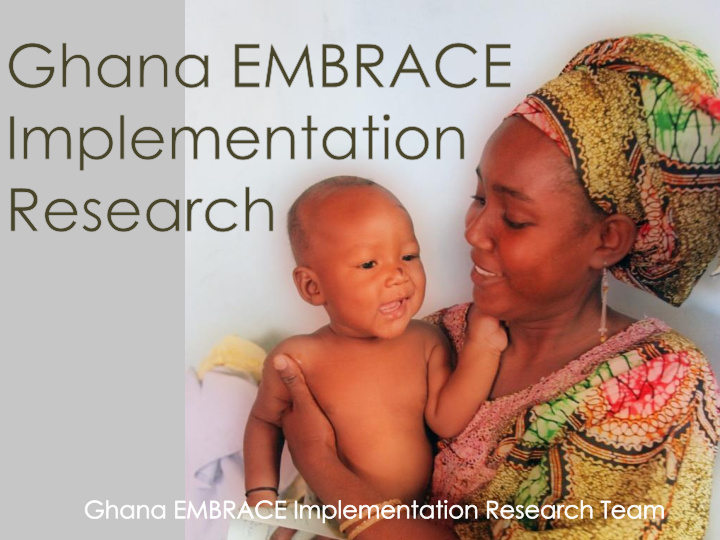



1
Maternal, Neonatal and Child Health Background in the World • Globally 289,000 women died due to complications of pregnancy and child birth in 2013 - 99% of maternal death occurred in MLIC countries • 6.6 million children under five died worldwide in 2012 - 80% of under five deaths occurred within 48h postpartum • MDG4 (reduce child mortality) - two-third MDG target countries are unlikely to achieve MDG4 • MDG5 (improve maternal health) - AARD* is far below the needed (5.5%) (WHO data in 2013) *AARD: average annual rate of decline Ghana EMBRACE Implementation 2 Research
What is the Ghana EMBRACE Implementation Research? E nsure M others and B abies R egular A ccess to C ar e In 2012, Japanese government in conjunction with Ghanaian government launched the Ghana EMBRACE Implementation Research Aims • To develop a pathway to create feasible and sustainable packages of interventions to improve MNCH outcomes and to test such packages in rural settings • To disseminate the findings and lessons learnt to the wider global health community Ghana EMBRACE Implementation Research 3
Continuum of Care (CoC) CoC definition in MNCH - often explained by the time and space dimensions - ANC for 4 times - Delivery assisted by skilled birth attendants - up to 67% of newborn deaths could be prevented by improving - PNC within 48h, at 7days, at 6weeks CoC (Haggerty 2003, Kerber 2007, Darmstadt 2005) Ghana EMBRACE Implementation Research 4
Study Sites in Ghana (Health and demographic surveillance system: HDSS) Navrongo HDSS site Kintampo HDSS site Dodowa HDSS site Ghana EMBRACE Implementation Research
Coverage of CoC related service indicators Kintampo Navrongo N=1,500 Dodowa 100% 90% 80% Low coverage of 70% first PNC 60% 50% 8.0% 40% 30% 20% 10% 0% ANC +4 Facility PNC 48h PNC 2wks PNC 6wks CoC delivery completed Ghana EMBRACE Implementation Research 6
Findings from CoC Situation Analysis Focus group discussion Retrospective survey Promoters for CoC Barriers to CoC Factors negatively ANC/Facility associated with CoC • Easy access to facility Delivery/PNC • Financial difficulties • Availability of • Low mothers’ education • Long distance& bad professionals & • Low partners’ education roads equipments to manage • Multi parity • Attitudes of HWs complications • Non married status • Positive attitudes of • Local beliefs • Lack of family support • Lack of preparedness HWs • Long travel time to • Ignorance facility • Perception of being well Ghana EMBRACE Implementation Research 7
EMBRACE Intervention Package CoC orientation for HWs Utilization of CoC Card 24h retention at facility Home visit PNC after delivery Ghana EMBRACE Implementation Research 8
Continuum of Care Card Ghana EMBRACE Implementation 9 Research
(Oct. 2014~ Sep. 2015) Ghana EMBRACE Implementation 10 Research
Initial Report of Intervention (Oct.~Dec. 2014) • Very high potential of adoptability • 5,809 CoC cards were distributed 2893 Oct. Nov Dec 1510 1406 1045 933 915 609 598 506 470 395 338 Dodowa Kintampo Navrongo Total 11
Navrongo • Approx. 600 women stayed at health facility for 24 hrs. postpartum and all received PNC within 48 hrs. Retention Facility visit Home visit B-1 coverage is high! 229 210 191 187 30 20 21 16 14 Oct Nov Dec 12
Kintampo • Home visit PNC has been favorably received, where women have custom to stay home for 6 weeks postpartum Effect of B-2 Retention Facility visit Home visit 68 66 61 Missing 44 data 37 27 26 19 0 Oct Nov Dec 13
Dodowa Retention Facility visit Home visit 168 Facility PNC and Home 106 24hrs PNC ↑ retention ↑ 53 37 28 27 23 20 9 Oct Nov Dec 14
Understanding CoC “ When I properly follow w the Co CoC card and do good behavior, or, I can get a gold ld star” “I want to get all gold stars “
Quality works “Using the Co CoC card, d, we we can now w spend quality ty time on each mother.”
Useful tool to convince mothers “Usually, women do not want to stay at facility after delivery. But looking at the CoC card, they understand that they should stay”
Beyond the “Traditionally, women of this region do not go out for 40 cultural barrier days after delivery. So, it is really good to visit their home and see if mother and baby are fine. They seem very happy.”
Discovering problems earlier “By home visit, many neonatal sepsis cases were found. It’s due to bad umbilical cord cutting practices, like use of salty sand and toothpaste” 19
Importance of 24h retention “ Yesterday, I atten tende ded a de delivery. ery. In the evening, g, I found d the baby had 38.6 ℃ , , so I referred.” “Now, I know how w importa rtant nt 24-hour our retention is.”
Study Protocol Registration & Publication RCT registration : ISRCTN90618993 http://www.isrctn.com/ISRCTN90618993 Trials 2015; 16: 22. Published online 2015 Jan 27. DOI 10.1186/s13063-014-0539-3 Ghana EMBRACE Implementation 21 Research
22
Recommend
More recommend